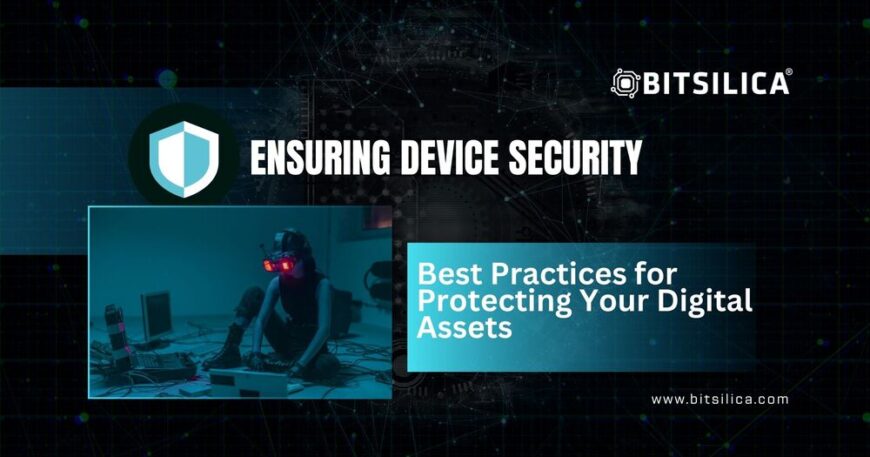Ensuring Device Security: Best Practices for Protecting Your Digital Assets
Introduction
Device security is a critical aspect of overall cyber security, focusing on protecting physical devices such as laptops, smartphones, tablets, and desktop computers from unauthorized access and threats. This blog post will explore best practices for securing your devices, ensuring that both personal and organizational data remain safe.
Understanding Device Security
Device security involves implementing measures to protect devices from theft, unauthorized access, malware, and other cyber threats. Effective device security practices are essential for maintaining the confidentiality, integrity, and availability of data.
Example: In 2018, the theft of an unencrypted laptop from a healthcare provider resulted in the exposure of sensitive patient data, highlighting the importance of robust device security measures.
Implementing Strong Passwords and Biometric Authentication
Passwords and biometric authentication are the first line of defense against unauthorized access to devices.
Best Practices:
• Strong Passwords: Use complex passwords that combine letters, numbers, and special characters. Change them regularly.
• Biometric Authentication: Enable biometric authentication methods such as fingerprint scanners or facial recognition for an additional layer of security.
Example: A 2020 study found that devices with biometric authentication experienced 80% fewer unauthorized access attempts compared to those with password-only protection.
Keeping Software Up to Date
Regular software updates are crucial for protecting devices from vulnerabilities that cybercriminals can exploit.
Best Practices:
• Automatic Updates: Enable automatic updates for operating systems, applications, and security software.
• Patch Management: Regularly apply security patches and updates as soon as they become available.
Example: The WannaCry ransomware attack in 2017 exploited a vulnerability in outdated Windows systems, affecting over 200,000 devices worldwide. Prompt updates and patches could have prevented many infections.
Using Encryption
Encryption ensures that data on your devices is unreadable to unauthorized users, even if the device is lost or stolen.
Best Practices:
• Full Disk Encryption: Encrypt the entire hard drive to protect all stored data. Example: BitLocker for Windows, FileVault for macOS.
• Encrypted Storage Devices: Use encrypted USB drives and external hard drives for additional security.
Example: In 2021, an unencrypted USB drive containing sensitive government data was lost, resulting in a significant data breach. Using encrypted storage devices could have prevented unauthorized access.
Enabling Remote Wipe and Tracking
Remote wipe and tracking features allow you to locate lost or stolen devices and erase data remotely to prevent unauthorized access.
Best Practices:
• Device Tracking: Enable tracking features to locate your device if it’s lost or stolen. Example: Find My Device for Android, Find My for iOS.
• Remote Wipe: Enable remote wipe capabilities to erase data from your device remotely if necessary.
Example: In 2019, a company was able to remotely wipe a stolen laptop containing sensitive client information, preventing a potential data breach.
Using Antivirus and Anti-Malware Software
Antivirus and anti-malware software protect devices from malicious software that can compromise data and system integrity.
Best Practices:
• Reputable Software: Use reputable antivirus and anti-malware programs and keep them updated.
• Regular Scans: Perform regular scans to detect and remove potential threats.
Example: In 2020, an organization’s antivirus software detected and neutralized a malware attack, preventing significant damage to their network.
Securing Physical Access
Physical security measures prevent unauthorized individuals from gaining access to your devices.
Best Practices:
• Lock Devices: Use physical locks for laptops and other portable devices when left unattended.
• Secure Workspaces: Keep devices in secure locations, especially when working remotely or in public spaces.
• Awareness: Be mindful of your surroundings and avoid leaving devices unattended in public places.
Example: In 2017, a laptop containing confidential data was stolen from a car, leading to a data breach. Locking the laptop or securing it in a less visible location could have prevented the theft.
Implementing Mobile Device Management (MDM)
MDM solutions help manage and secure mobile devices used within an organization, ensuring compliance with security policies.
Best Practices:
• Policy Enforcement: Use MDM to enforce security policies, such as password requirements and app restrictions.
• Remote Management: Enable remote management features to update settings, deploy apps, and perform remote wipes.
Example: A 2019 survey found that organizations using MDM solutions experienced a 60% reduction in mobile device-related security incidents.
Conclusion
Securing your devices is essential for protecting sensitive data and maintaining overall cyber security. By implementing strong passwords, keeping software up to date, using encryption, enabling remote wipe and tracking, using antivirus software, securing physical access, and utilizing mobile device management solutions, you can significantly reduce the risk of unauthorized access and data breaches. Stay vigilant and proactive in securing your devices to protect both personal and organizational data.





